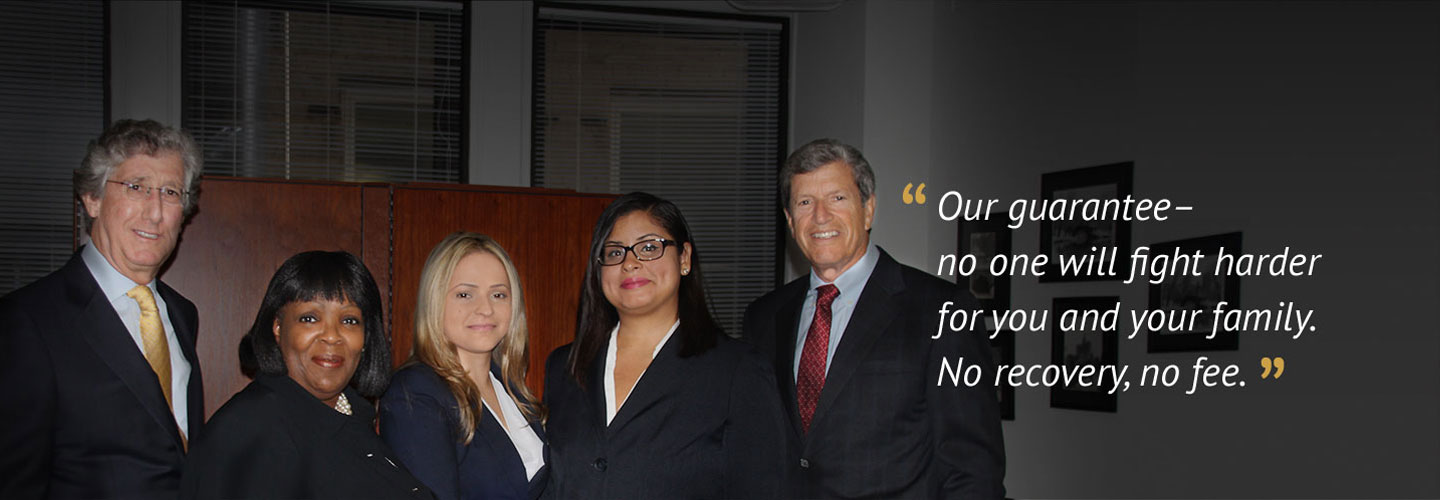New York Medical Malpractice Attorneys
New York Medical Malpractice Attorneys
New York Medical malpractice attorneys file cases when a doctor, hospital or nurse, does something or fails to do something that violates the applicable standard of care. New York law mandates that every patient within its borders is entitled to good and accepted care that falls within the standards developed and maintained by doctors and nurses. The law recognizes that it is the health care providers, and not lawyers, who set the standard of care; but once a standard is developed, the responsibility falls on the providers to deliver standard and not sub-standard care.
In order for a patient to receive money damages, it is not enough to simply prove a deviation or departure from care-the plaintiff must also prove that the negligence was a substantial cause of the claimed injury.
The burden of proof falls on the plaintiff to prove in court that a standard existed at the time of treatment, and that the doctor’s action or inaction fell below the proven standard. In most every case, the patient must produce an expert to swear that she is familiar with what good and accepted care required, and that the defendant provided substandard care. Once this threshold is crossed, the expert can then give an opinion that the patient’s injuries were a direct consequence of the negligence.
Free Consultation – Call 212-233-3133
New York Malpractice
New York defines malpractice as the negligence of a doctor or other health care provider. The most up to date definition of malpractice in New York, as conveyed in the instructions given to the jury at the end of the case, is as follows:
Negligence is the failure to use reasonable care under the circumstances…It is a deviation or departure from accepted practice… A doctor must use…whatever superior knowledge or skill he/she possesses.
New York has long recognized that in non-emergency situations, a doctor has the duty to provide certain information concerning what the doctor proposes to do, the alternatives to the proposed course of action, and the reasonably foreseeable risks attendant to the operation, procedure or medication. If a physician fails to provide the proper information, and the jury finds that a reasonably prudent patient would have decided to forgo the treatment, the patient may collect damages due to “lack of informed consent.”
New York Medical Malpractice Damages
Except in extraordinary circumstances where a lay juror can determine that an injury is connected to negligence, New York law demands expert testimony to link a deviation from the standard of care to the plaintiffs specific injury. For example, if the claim is made that during an emergency department visit the doctor failed under the standard of emergency care to diagnose an impending heart attack, the expert must testify with reasonable probability that the heart attack which followed the next day, and which caused significant heart muscle damage, was substantially caused by the negligence. In other words, the law requires an expert to give the opinion that “but for” the defendant’s negligence, the heart attack could have been prevented. The defendant’s negligence need not be the only cause of the injury, or even the most important cause; it is enough that a reasonable person would say that the negligence was a substantial factor in causing the injury.
Expert’s need not always testify that there was a more than 50% chance that following the standard of care would have prevented an injury. If the expert can testify, based on medical knowledge and facts, that if the proper care had been given there was a ‘substantial possibility” that the injury could have been prevented, even though this is less than 50/50, the plaintiff may prevail.
Patients may recover monetary damages for both physical and emotional damages. If the jury finds that the plaintiff is entitled to recover damages, the jury is instructed that they must render a verdict for a sum of money that “…will justly and fairly compensate the plaintiff for all losses resulting from the injuries he/she sustained
In New York, the courts recognized that “loss of enjoyment of life,” can be compensated in appropriate cases. Unlike New Jersey, the New York courts require that the injured party have some “awareness” of the loss; thus, patients who are in a fully comatose state, are unable to collect for loss of enjoyment of life.
New York Medical Malpractice allows law suits for damages that occur as the result of “wrongful” death. The courts have held that the survivors may not collect damages for love or grief, but rather are restricted to pecuniary-that is-economic damages. An example of pecuniary damages would be the lost wages that occur upon the death of a spouse. In order to bring a case for wrongful death, an executor or administrator must be appointed by the court.
Time to sue: Statutes of Limitations for New York Medical Malpractice Attorneys
The law does distinguish between adults and infants(those less than 18 years of age) when it comes to setting time limits in which to sue. The purpose of time limits, known as Statutes of Limitation, is to prevent stale claims from being brought. In New York, a suit for medical malpractice which involves bodily or emotional injuries, rather than death, must be brought within two and one-half years after the act of malpractice.
Unfortunately, New York does not have a discovery statute of limitations, so the time to sue may expire before the patient even knows she has a case. For example, suppose that on January 1, 2012, a patient goes for a routine chest x-ray. The chest x-ray shows a small mass on the lung, which is likely a cancer. The radiologist, failing to meet the standard of care, fails to mention the mass in his report, and no diagnosis is made or treatment begun. Two years and seven months after the x-ray, the patient develops a cough, and after a work-up, it is learned that the small mass seen earlier is now very large, and has spread throughout the body. Despite having all the elements of a malpractice case, the patient is out of luck, because more than 2 ½ years has passed.
In some cases, the 2 ½ year limitations period can be extended through a doctrine known as continuous treatment. Simply put, if a patient has been seeing a doctor for a period of time for a particular condition, the statute may not begin to run after all treatment is ended, rather than from an earlier, discrete event. Unfortunately, the courts are not very liberal in applying this exception, and may patients with meritorious cases are barred from bringing suit.
Decades ago, in response to a so-called crisis, the law was amended to address malpractice relating to babies and youngsters. When an injury occurs at birth, the suit before the minors 10th birthday. In those cases that occur prior to a child’s 18th birthday, and do not revolve around a birth injury, the child has 10 years from the time of injury to commence a lawsuit, but no more than 2 ½ years from his/her 18th birthday.
Free Consultation – Call 212-233-3133
In cases involving death, the suit must be started within two years after the date of death.
In some cases, depending on the entity in question and whether there are “public employees” in question, a notice of claim must be filed within 90 days of the act of negligence. For example, hospitals in New York City run by the Health and Hospitals Corporation fall under the 90 day notice of claim requirement. In addition, personal injury cases against these hospitals must be brought within one year and ninety days form the incident.
In cases involving a retained foreign object, such as a clamp, scissors, or sponge, the patient may bring the suit within 2 ½ years of the incident, or within one year from the time it actually became known that the instrument was left behind. In order to take advantage of the one year “discovery” period, the object must be truly foreign, meaning that it was never intended that the object stay in the body beyond the completion of the surgery or procedure.
New York City Medical Malpractice Law Firm Videos
New York Medical Malpractice and Injury Attorneys, Hess & Leibowitz have successfully represented individuals in many thousands of personal injury and medical malpractice cases over the past three decades. And, we have recovered money for our clients through settlements or judgments in 98% of those cases.
Free Consultation – Call 212-233-3133


